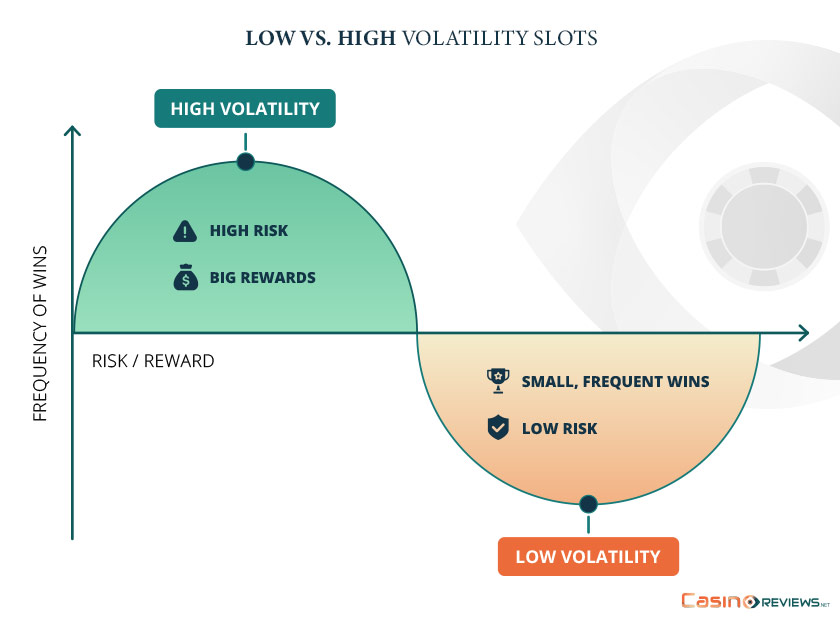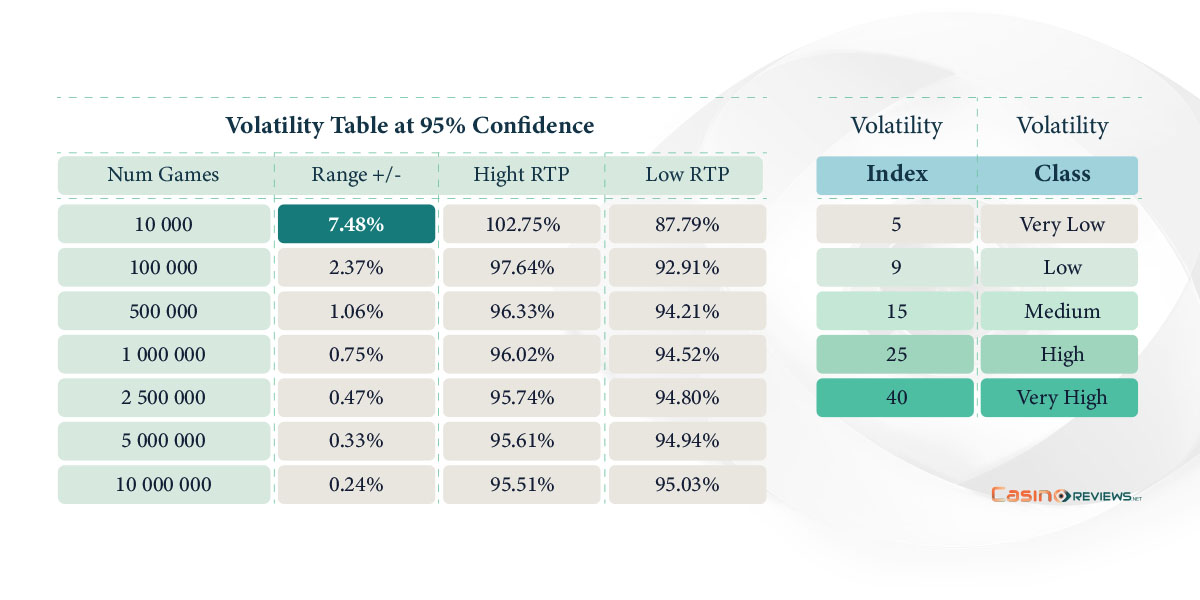Low vs High Volatility Slots – What Is the Difference and How to Choose Which Game to Play

The game of slots does not allow optimal strategies to be developed mathematically, like blackjack, for instance. In slots, the only strategy of a player is that of choosing, and such choices refer to particular games, playing time, enabled paylines, multiplication of the bets, and so on.
The strategies of choosing may be, of course, subjective or objective, depending on the nature of the criterion that drives them. Using a mathematical criterion in order to follow an objective strategy is yet very limited due to the fact that mathematical characteristics of the game of slots are usually kept secret by their producers. Still, there are two statistical indicators that sometimes are exposed or can be found, namely the RTP (Return to Player) and volatility.
What Does Volatility Mean in Slots?
In general, the RTP of a game is the fixed percentage of its income (coming from the lost bets) that is returned over the long run to the players as wins. RTP is a reflection in practice of the expected value and implicitly house edge (HE). RTP is actually one minus HE. In terms of averages, RTP = (average win/average bet) × 100%.
But what about volatility, and what does high volatility mean exactly? Volatility is a gambling-math term reflecting in practice the statistical notion of variance. Variance measures the deviation of the data (the values of the random variable) from the mean or expected value as an average of their squared deviation. Hence it does not measure a central tendency, like the mean or expectation, but a dispersion or variability. Variance measures how the data are spread out from their mean. In gambling terms, variance gives a measure of how often, on average, the game pays its players, as well as of how the winning amounts are distributed over time.
In gambling statistics jargon, the term volatility is used as related to variance (sometimes interchangeably), especially in slots. Volatility is variance over a definite interval of time or number of plays, and it is often expressed as a number on a 1-to-5 or 1-to-10 scale. It is also usually labeled as low, medium, or high. Game providers express volatility differently, and there is no industry standard for measuring slots volatility.
Volatility reflects the distribution in prizes of the RTP over a given number of plays, that is, how often and how big the wins are on average over that interval. While variance reflects how the RTP is distributed in wins over the long run (to infinity), volatility reflects this distribution over a definite playing interval, which still must be long enough for that indicator to be accurate.
Roughly speaking, in low volatility slots, you can expect more frequent wins and in smaller amounts than in high-volatility slots, where you may wait some time before hitting a win (Figure 1). This is the frequentist interpretation of the volatility category of the game, which submits to the same general principle in gambling of balancing advantages and disadvantages toward a constant – in this case, the RTP.

Figure 1: Low vs. high volatility slots
Some slots operators or producers expose the volatility of their games along with the RTP, but most of them do not. For the latter, you have to guess whether it is about a low-, medium- or high-volatility game. Yet, this guess may be driven by objective information.
How to Determine Slots Volatility
You may determine the volatility category of a game by looking at its payout table. Usually, the games that offer high prizes (×5,000, ×10,000, etc.) for the top winning combinations (those with the lowest probability of occurrence) or big difference between the lowest and the highest prize are high-volatility games; games offering bonuses (free spins, additional payouts beyond the main payout table, etc.) are likely to be high-volatility games.
A more precise method of finding the volatility of a game (as well as its RTP) is through direct statistical observation over the long run. However, this is a very difficult task, assuming you have to record spins in a number of thousands in a machine and do statistical work on the data. Usually, the players of a specific slot game share their experiences with that game over the long run, and rough labeling in low, medium or high volatility of the game is contoured based on the information about the frequency of their wins and the amounts won. Yet, the statistical method based on direct observation is able to provide a more accurate estimation of how volatile slot machines are.

Figure 2: How to find out the volatility category of a slot game
Choosing Objectively by Volatility
With the above definition of RTP and assuming the RTPs of the games one has to choose from are known, it is clear that the first criterion of choosing a slots game is the RTP – the higher the RTP, the better.
Under the assumption that the volatility of a game is known or at least labeled as low, medium, or high, the question arises as to whether objective criteria of choosing by volatility may be used in the play. Between games with the same or about equal RTPs, when do you need to choose one by its volatility? Or when to choose simply by volatility, ignoring the RTP?
The factors to be considered for setting up an objective strategy of choosing slots by volatility are the bankroll and intended limit of playing time, which are related. Bankroll management is the main factor that determines the employment of volatility in such a strategy.
For a player with a low bankroll, it may be useful to start with low volatility slots so that possible constant winnings can consolidate the bankroll long enough to move on to medium or high volatility slots in which to chase higher prizes if the profit is the only motive.
This strategy may change if the time-spent factor is considered. A player with a large bankroll may choose to start with medium- or high-volatility games, but of course, the other option is not excluded. For a player deciding to play very long sessions regardless if limited by the bankroll, the distinction between low and high volatility may not be taken into account when choosing.
Players who also play for progressive jackpots may choose to play with multiplied credits since most progressive jackpot games require maximum wagers in order to be eligible for the jackpot amount (×2, ×3, ×4, or ×5 credit/coin, per the particular rule of the casino). Of course, such a strategy is not recommended when playing a high volatility slot with no progressive jackpot goal, especially with a relatively low budget.
Therefore, there is no absolute strategic recommendation to play low or high volatility games like, for instance, playing American roulette instead of European roulette, just because the latter has a higher house edge. The above recommendations are conditioned by factors beyond the mathematical characteristics of the game, including objective (like bankroll and playing time) and subjective.
Conclusion
As long as the long-run play is concerned, from a purely mathematical point of view, the distinction between low-, medium, and high-volatility games in terms of player’s advantage is useless since all reverts back to the expected value and thus RTP.
Imagine a hypothetical slot game where the software developer decides to change its payout table so that to maintain the same RTP but decrease its volatility from a medium or high to a low one. A player who constantly plays that game will make, on average, the same wins over the long run in either situation. A new player trying that game in its low volatility version might be influenced instead by some regular small wins to remain in that game.
It is a sort of “statistical advertising” that makes volatility a means of by-design manipulation in the developer’s favor. Still, should the RTP and volatility of the game be known in advance, that manipulation would be innocent, which is not the case with the engineered false near-misses.
References:
Bărboianu, C. (2022). Understanding your game: A mathematician’s advice to rational and safe gambling. Târgu Jiu: PhilScience Press.
Harrigan, K. A. (2007). Slot machine structural characteristics: Distorted player views of payback percentages. Journal of Gambling Issues, Vol. 20, 215-234.
Harrigan, K. A., & Dixon, M. (2009). PAR Sheets, probabilities, and slot machine play: Implications for problem and non-problem gambling. Journal of Gambling Issues, Vol. 23, 81-110.
Turner, N. E. (2011). Volatility, house edge, and prize structure of gambling games. Journal of Gambling Studies, 27(4), 607-623.





Review this Blog
Leave a Comment
User Comments
comments for Low vs High Volatility Slots – What Is the Difference and How to Choose Which Game to Play